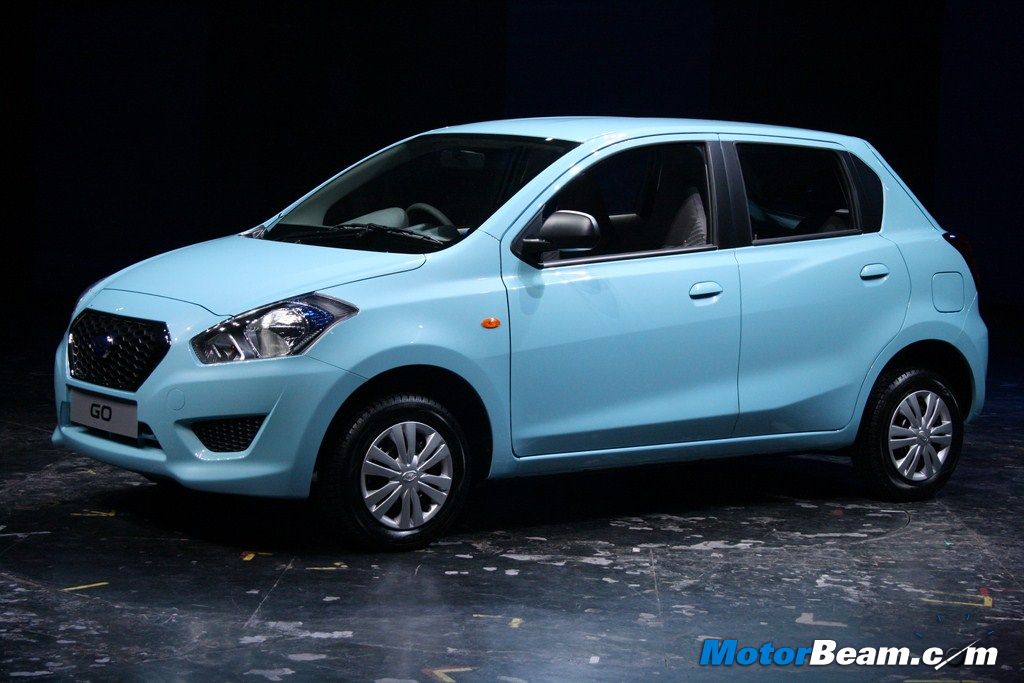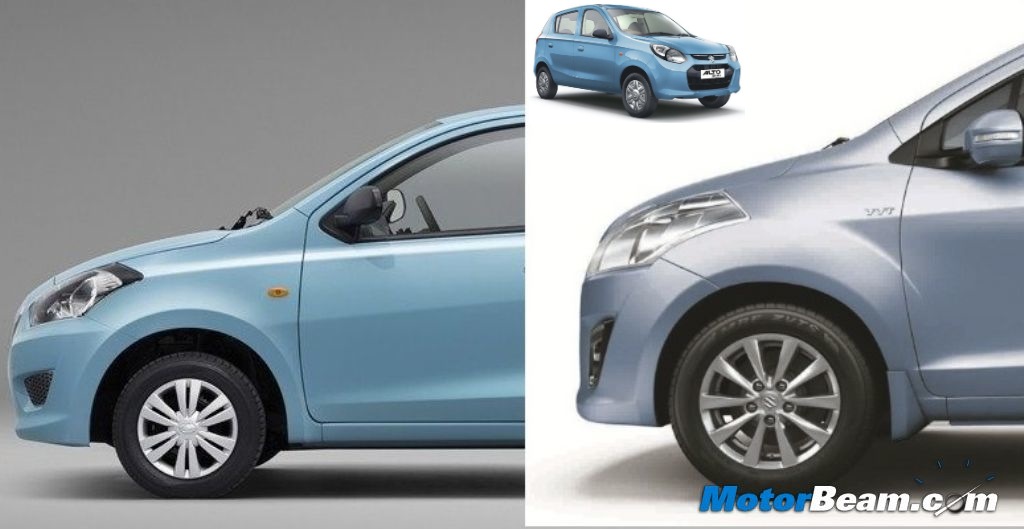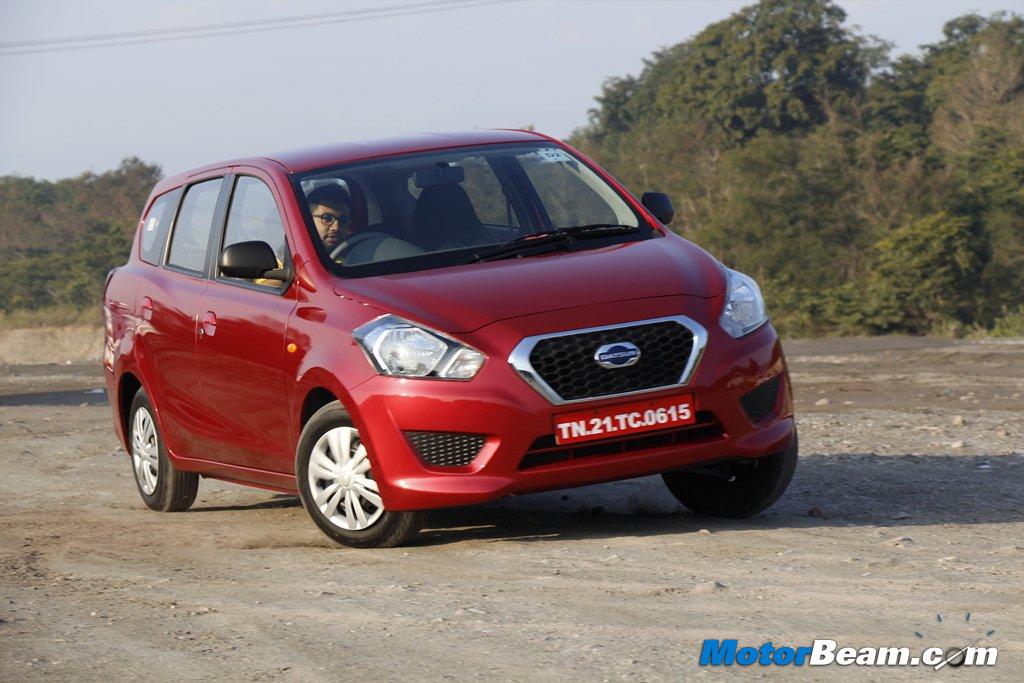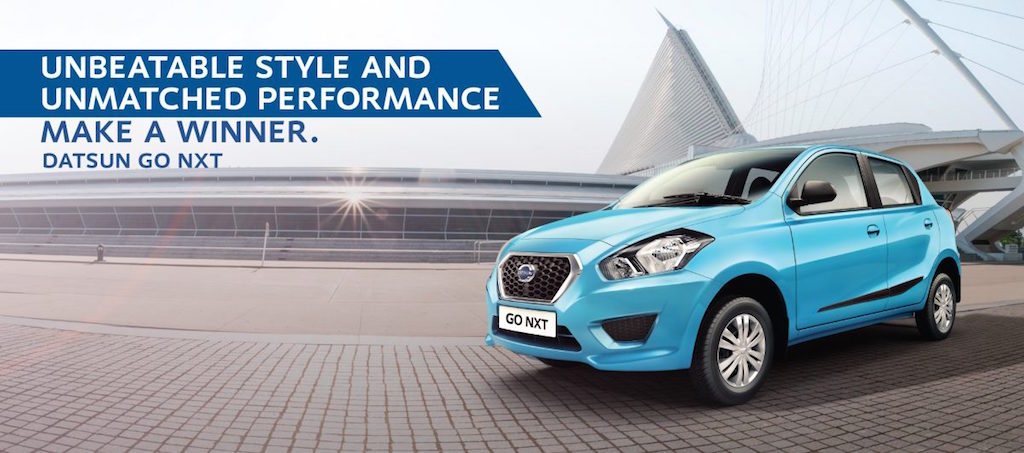Nissan has unveiled the Datsun GO hatchback in India today, which was the global premiere of the vehicle. This shows the importance of India for Datsun. India is one of the four emerging markets where the Datsun GO will go on sale next year. Nissan has proved it with the Datsun GO that cheap cars needn’t look cheap. The design of the Datsun GO looks decent and cost cutting is not so evident, unless of course you see with a keen eye when you will realise the vehicle has a single wiper, black coloured rear view mirrors, no rear wiper/washer and defogger, no fog lights, no roof antenna (production model should have it), single-din audio player, no rear power windows, open glove box, no cup holders and no internally adjustable rear view mirrors. Some of these features are offered by competitors while higher variants (priced higher) come with even more features (including safety features) which won’t be offered on the GO. The Datsun GO does get a docking station for your smart phone.
Nissan wants to increase its volumes in India to 10% from the current 1.2%. The company is getting into the volume churning small car segment with Datsun, a segment long dominated by Maruti Suzuki. Thus Datsun has looked at India’s largest car maker with a keen eye and you can’t help but notice a few similarities. From the side profile, the front end of the Datsun GO is reminiscent of the Ertiga (the headlight, bonnet and A-pillar). The colour showcased on the Datsun GO is very close to the frost blue seen on the Alto 800. While we are at it, the wheel caps resemble the ones on the Swift and the tail lights have a slight resemblance to the Toyota Etios Liva’s tail lamps.
[flickr size=”center” float=”medium”]http://www.flickr.com/photos/motorbeam/9289415961/[/flickr]
Similarities aside, the Datsun GO is based on the Nissan Micra. Both cars have the same wheelbase at 2450 mm but the GO is expected to offer better interior room thanks to the design of the cabin. The gear lever is mounted on the dashboard like the Hyundai i10 and the front seat is a single piece unit with integrated headrests. These are clear signs of cost cutting but if Nissan is able to price the Datsun GO very aggressively, these things can easily be overlooked. The handbrake is placed next to the gear knob, on the lower left of the steering wheel.
[flickr size=”center” float=”medium”]http://www.flickr.com/photos/motorbeam/9292436660/[/flickr]
Three people will be a difficult fit at the front even though the front seat is a bench. With three seated, changing gears will become difficult, if you know what I mean and the area between the seat belt knobs is too less for anyone to sit comfortably. The door handles, AC vents and instrument cluster are a direct lift from the Micra. The Datsun GO has decent legroom at the rear which can match rivals with ease. The boot capacity of the Chevrolet Beat is 170-litres, Maruti WagonR’s is 180-litres, Hyundai i10’s is 225-litres while the Nissan Micra’s is 251-litres. The Datsun GO’s boot looks even bigger.
[flickr size=”center” float=”medium”]http://www.flickr.com/photos/motorbeam/9292435910/[/flickr]
The Datsun GO will compete with the Chevrolet Beat, Hyundai i10, Nissan Micra Active (which we feel will be discontinued before the GO goes on sale) and Maruti Suzuki WagonR. By 2014, Maruti Suzuki would have launched a new model which replaces the Estilo and A-Star. The Datsun GO will have to fend off competition from the new vehicle too (codenamed YL7). As the below table shows, the Datsun GO is quite strong in certain areas and is the longest in its segment with the biggest wheelbase too. Naturally the Datsun GO will beat rivals when it comes to cabin space but do entry-level car buyers give as much importance to interior room as much they give to mileage?
Nissan is targeting first time car buyers with the Datsun GO. Mileage and ease of service (how far is service workshop and what is the cost of service) are extremely important to these type of buyers. While Nissan has addressed the cost of purchase by heavily localising components, it will be difficult to compete with Maruti Suzuki and Hyundai in other areas. The Micra Active returns a mileage of 19.49 km/l while the WagonR returns 20.51 km/l, the Hyundai i10 1.1 returns 19.81 km/l and the Chevrolet Beat petrol returns 18.6 km/l (all figures ARAI certified). The Datsun GO uses the same engine as the Micra Active and thus mileage is going to be similar too. While the difference in mileage is not really much between the above cars, when it comes to performance, the Micra’s petrol motor isn’t as slick as its rivals (especially the K10 engine powering the WagonR).
[flickr size=”center” float=”medium”]http://www.flickr.com/photos/motorbeam/9289415311/[/flickr]
Nissan has 100 dealerships in India, Maruti Suzuki has 1200, Hyundai has more than 380 while General Motors has 260. Clearly Nissan has a big disadvantage here which gets amplified when the company tries to launch an all new brand which has never been sold in India before. Forget Datsun, few people are aware about Nissan in India which is the reason why the highly capable Micra doesn’t sell in high numbers. Before Nissan entered India, people knew Nissan as the makers of the Jonga (Jabalpur Ordnance aNd Guncarriage Assembly) which was supplied to the Indian army.
[flickr size=”center” float=”medium”]http://www.flickr.com/photos/motorbeam/9289660649/[/flickr]
Maruti Suzuki sold 20,000 units of the Alto 800 last month and keeps selling around 16-18,000 units every month. However you don’t see much of the Alto 800 in cities because it’s really the Tier-II and Tier-III markets where entry level cars are mostly sold. Nissan needs to increase its dealership count quickly. The company plans to expand to 300 outlets by 2017, which is quite slow. Nissan needs to do what Ford did, open 50 showrooms in a day!
[flickr size=”center” float=”medium”]http://www.flickr.com/photos/motorbeam/9292437818/[/flickr]
Nissan cars are not expensive to maintain, in fact some of them are the cheapest in their segment for ownership costs. However people have a myth that Maruti Suzuki cars are the cheapest. Nissan needs to communicate their affordable service costs to prospective customers, which is crucial for Datsun to be successful. Besides this, dealers should be trained to handle the additional volumes so customer’s don’t feel dissatisfied.
[flickr size=”center” float=”medium”]http://www.flickr.com/photos/motorbeam/9289663055/[/flickr]
Nissan sold 2954 units last month, a 42% growth over the preceding month. Maruti Suzuki on the other hand sold 9395 units of the WagonR alone while Hyundai sold 8174 units of the i10 (4721 units of the Santro which is also a competitor to the Datsun GO) and General Motors sold 2081 units of the Chevrolet Beat. Clearly the Datsun GO’s competitors are well settled in the market with the brands having excellent awareness too. Nissan doesn’t have it easy with Datsun but the company has the capabilities to unsettle competitors.
Do you think the Datsun GO will work in India? If yes, why, if no, why not?






